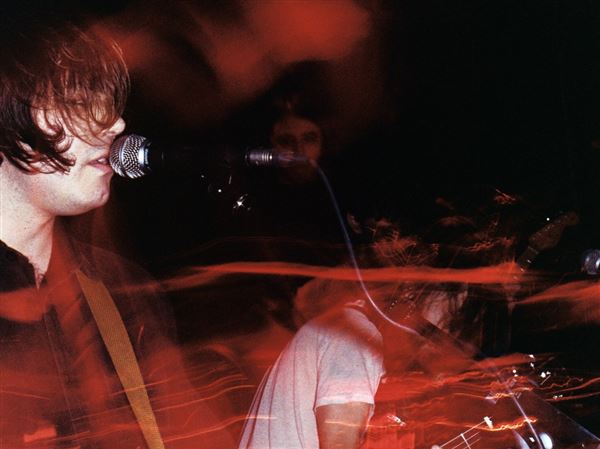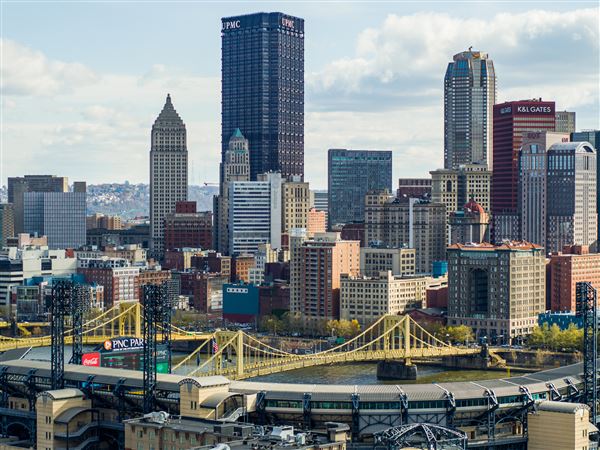Architect Joseph M. Huston won the 1901 design competition for the Pennsylvania State Capitol in Harrisburg with a grand vision to build a "palace of art" that would reflect the state's history and industrial prowess.
To that end, he brought artists into his project, among them Violet Oakley (1874-1961), whom he invited to paint 13 murals for the Governor's Reception Room. It was the largest public commission given to a woman in the United States to date and it established her reputation.
The preparatory studies for those murals are exhibited at the Westmoreland Museum of American Art, Greensburg, in "Violet Oakley: The Founding of the State of Liberty Spiritual," circulated by the Capitol Preservation Committee.
The artist, author and peace activist will be brought to life tomorrow night in "Violet Oakley: Voice of One," a one-woman theatrical performance by Central Pennsylvania actress Heather Jannetta (7 p.m., free admission).
In preparation for her project, Oakley traveled to Italy in 1903 to study Italian masters who influenced her style and palette. In England, she researched the life and formative years of William Penn, concluding that rather than addressing the state or colonization, as Huston had urged, her murals should address Penn's ideas of religious freedom and pacifism.
Upon her return to her home in Philadelphia that fall, she determined her mural series title, "The Founding of the State of Liberty Spiritual," and that she would depict events in Europe that influenced Penn's life course.
Thousands of people attended the murals' unveiling on Nov. 24, 1906, and the Pennsylvania Railroad offered special excursions to the new Capitol. Oakley was presented with the Gold Medal of Honor from the Pennsylvania Academy of the Fine Arts, the first woman to receive the award.
Later, Oakley would paint murals for the Senate and Supreme Court Chambers, completing 43 murals for the Pennsylvania Capitol. A successful artist and illustrator, she would also remain a global voice for world peace and justice throughout her life.
A reminder that "Scenic Views: Painters of The Scalp Level School Revisited," 69 not previously exhibited paintings by 23 artists of the 19th- century Western Pennsylvania artist group, closes Sunday at the Westmoreland.
The exhibition had drawn almost 6,000 visitors by the beginning of the week, placing it among the most popular shows in the museum's history.
Museum director/CEO Judith Hansen O'Toole, who curated the show and is writing a book on Scalp Level, said some visitors have returned two and three times. As word of the exhibition and the Pennsylvania school has traveled, she's received expressions of interest and/or congratulatory notes from colleagues for bringing the less well-known but deserving artist group to public attention, ranging from Washington, D.C. (the Smithsonian's Archives of American Art) to Oregon (St. Louis Art Museum Executive Director Emeritus James Burke).
A bonus has been the discovery of additional paintings and archival material in the possession of family members of three of the artists, who now live in other parts of the country and contacted O'Toole after learning of the exhibition.
Besides landscape (some outside of Pennsylvania), subject matter includes still life and genre scenes. Eleven paintings are by George Hetzel, leader of the Scalp Level School, including the sylvan glades for which he is most known but also still lifes and "Indian Encampment," the only known Hetzel work showing European settlers encountering Native Americans.
The paintings reflect their time period, including shifts in formal expression the artists were experiencing. Compare, for example, Joseph R. Woodwell's 1878 woodland cottage, so typical of the Barbizon School he would have become familiar with while studying in Paris; the 1899 Niagara Falls scene, a traditional Hudson River School subject updated by perspective; and his 1910 Massachusetts seaside scene, Impressionist in palette and brush.
Of particular interest are two (among six) paintings by Scalp Level senior artist, self-taught William Coventry Wall -- a "Winter Scene" of a village nestled along a river, suspended in winter's gray and white cold, that was recently purchased by Carnegie Museum of Art; and "View Along the Allegheny Near Aspinwall, Pa.," a recent gift to the Westmoreland, showing an expansive and luminous landscape of fields and hills, barely tinged by the incoming colors of autumn, an allusion to the arrival of settlers and the inevitable passing of wilderness.
While not every painting is a masterwork, each contributes to understanding this significant regional cultural component.
"Oakley" continues through March 29 at 221 N. Main St., Greensburg. O'Toole will give a free talk on Oakley's Capitol work at noon March 11. Museum hours are 11 a.m. to 5 p.m. Wednesdays through Sundays and until 9 p.m. Thursdays. Admission is a $5 suggested donation for adults; children under 12 are free. For information, call 724-837-1500 or visit www.wmuseumaa.org.
Pittsburgh Center for the Arts 2009 Artist of the Year Tim Kaulen is looking for donations, until March 31, of recycled materials for a sculpture he's creating for his exhibition, including steel pipe and tubing; copper, aluminum and steel wire; nuts and bolts; scrap fencing, lighting fixtures and rebar. For specifics, e-mail him at tkaulen@gmail.com.
First Published: January 28, 2009, 5:00 a.m.














